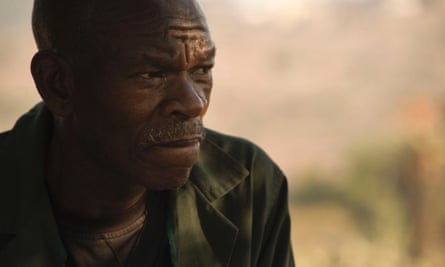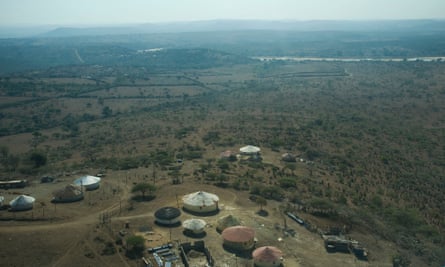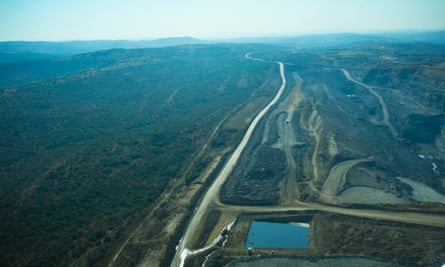The surface of a pool near the Imfolozi river ripples as a white rhino, its young calf close by, lowers its mouth to drink. Rhinos have roamed the Earth in such a way for 40 million years. Humans, by comparison, are new kids on the block.
Yet it is modern man that threatens to drive these stately creatures to extinction. Figures released last week show that 558 rhinos have been slaughtered in South Africa so far in 2014, putting it on course to be the deadliest year of poaching since records began.
Well-armed gangs continue to run riot, shooting the animals with impunity and hacking off their horns, said to be more than worth their weight in gold on the black market. Now conservationists warn of a new threat – voracious mining – that could drive the endangered animals to the brink.
The Hluhluwe-Imfolozi park in KwaZulu-Natal province, a natural oasis abundant in elephants, leopards, lions and more than 300 bird species, is arguably the world’s greatest rhino sanctuary and ground zero in the battle to save them. Once the exclusive hunting ground of Zulu king Shaka, it is the oldest protected wilderness in Africa, proclaimed in 1895, and the scene of one of the most inspiring conservation success stories of the 20th century.
By the 1890s southern white rhinos – "bigger and more numerous than black rhinos" – had been hunted to near extinction and Hluhluwe-Imfolozi was their final refuge. But in the 1950s, the park carried out the first aerial count of any species in the world and found 437 white rhinos remaining. The population was nurtured and grown and carefully distributed to other areas where they could breed to form new populations. There are now an estimated 20,000 southern white rhinos in the wild.
Yet this historic achievement is being undone at a terrifying pace. Most rhinos are in South Africa, which has seen a dramatic surge in poaching from 13 killed in 2007 to 1,004 last year. With every measure apparently failing, the government has been forced to think the unthinkable and seek expert input on talks about possibly legalising the rhino horn trade.
Hluhluwe-Imfolozi is not immune, with nine slain so far this year. Two staff members at the park, which has the densest concentration of rhinos in the world (it refuses to say how many), have been suspended following an investigation into poaching, which is fuelled by the insatiable medicine trade in Vietnam and China.
“It’s a war that’s becoming worse and worse every day,” said Peter Rutsch, an environmental lawyer monitoring the park. “The benefits that the mafia syndicates are paying to communities to poach are so high that it’s becoming increasingly difficult to say to them, ‘Do something else’.”
Now, activists say, there is a new peril on the horizon. A mining company, Ibutho Coal, has applied to build a colliery just 40 metres from the boundary of the protected wilderness. The 14,615-hectare (36,099 acres) opencast mine would, opponents say, pollute air and rivers, displace local communities and hasten the demise of the rhino. This magnificent rolling savanna would, they argue, be scarred by waste dumps up to 70m high.
The contention points to wider concerns over the extraction of mineral resources and its impact on the Africa’s biodiversity. In South Africa alone, government figures show, the number of operating mines has increased from 993 in 2004 to 1,579 in 2012. The Guardian flew over Hluhluwe-Imfolozi park and witnessed how coalmines already operating just outside its borders form black cavities in the otherwise pristine green landscape.

Standing under a thorn tree with a beautiful vista of the park, Bhekukwenzelwa Ndimande, a Zulu community leader in Fuleni who is fiercely opposed to the mine, said: “We are concerned the wild animals like rhinos and elephants will go extinct. We will be the last to know about these animals and the next generation will know nothing.”
The community’s fears are driven mostly by the development in 2008 of the Somkhele coal mine six miles away. They complain that their houses are cracking due to the blasting of coal out of the ground and pollution is already putting them in danger.
Ndimande added: “When they are blasting on that side, the dust travels here. Here we are living with asthmatic people and the dust has an effect on them. Our cattle drink the toxic from that side and die. Now they are preparing to mine the grazing land of our cattle.”
As Ndimande spoke, dogs, goats and hens wandered amid nearby cactuses, dried grass and modest houses. The community has known the same way of life for generations and resents the prospect of losing it for a mine expected to operate for about 40 years. “We’ve managed to bring up our children from selling cattle. The children are now doctors and lawyers. If the mining opens the land, how will our cattle be able to graze and how will our children go to school?
“We have a school and clinic and our own roads. If the mine comes, all of them will be taken away. The mine is going to oppress us.”
Ndimande’s son, Phila, said 18 of his cattle had died from illness in the past year. “We are losing our livestock rapidly from mysterious diseases which we think are related to mining in this area. There is blasting from the mines which are nearby. Our water resources for the cattle are polluted. Last weekend, I saw this dead bull on the banks of the Imfolozi river.”
Phila, a technician, warned that the mine project would hurt rhino security: “It will be easy for poachers to access the park. Right now we have communities working with the reserve to ensure it’s inaccessible. If the mine comes, no one will be able to monitor who comes in and who comes out.”

This anxiety is shared by Roger Porter, an ecologist and former head of conservation planning at the provincial body Ezemvelo KZN Wildlife. Asked if the mine would lead to an increase in poaching, he replied: “Without doubt. Mines tend to be a magnet drawing in people from surrounding areas because of jobs. Universally crime increases around mines and poaching is a crime.”
Rhinos and other animals will also suffer harmful side-effects, Porter believes. “What we do know is that blasting affects crocodiles so they no longer breed. There is some evidence of possible crocodile mortality as a result of vibration. We also know that elephants ‘hear’ through their feet; with these vibrations, what’s going to happen now? We have no idea what the blasting effect would be on rhinos.”
He added: “We have concerns about dust. There’s no analysis of the toxic dust and you can feel this wind blowing across us into the park. The fall-out would be in a wilderness area.”
As South Africa seeks new energy sources to meet ever-rising demand, providing electricity to black communities who previously denied it under racial apartheid, the tensions are clear. Under pressure from the UN, the government this month announced a new buffer zone around the 1,100-year-old Mapungubwe world heritage site in Limpopo province, a coal-rich area targeted by numerous prospecting and mining applications. Porter said: “It’s ironic that some of South Africa’s richest coal chests lie beneath key biodiversity areas.”
The threat to Hluhluwe-Imfolozi is heartbreaking for Dr Ian Player, the man who thought he had fought and won the battle to save the rhino in the 1950s and 60s. It was Player, who began working here as a ranger in 1952, who led the first aerial count and launched the now celebrated “Operation Rhino”, breeding the animals in the park then reintroducing them into other protected areas in the subregion. The lessons learned are still used today to protect endangered species around the world.
Now 87, the eminent conservationist and brother of golfer Gary Player fears the loss of what is most precious. “There is no doubt in my mind that if that mine went ahead it would destroy the wilderness,” he said. “If we don’t save wilderness, I am afraid humanity is on one long path towards destruction. And what a tragic world it would be if your children and your grandchildren couldn’t see a rhino in the wild.”
Player believes there is still hope, however. He urged: “A message to those who are struggling: don’t let bureaucracy kill great ideas. That is the most important thing. People were saying its impossible, you can’t defeat these big mining companies, and we said no, you can, but you’ve got to know that what you are doing is absolutely right. You have to know that. If you know that, then the rest is strategy and tactics.”
Last month Avaaz, the global campaign network, warned the South African government in a letter: “Any additional threat to South Africa’s rhino population, such as this opencast mine, is simply unacceptable. The proposed mine would not only wreck the Imfolozi wilderness and pave the way for poachers, but it would also risk polluting the rivers feeding the Unesco world heritage-listed Isimangaliso wetlands.”
Ayanda Shezi, a spokesperson for the mineral resources department, said the application is undergoing the standard environmental impact assessment and public consultation process. “The department will assess the results of consultations and if there are any objections, those will then be forwarded to the regional mining development and environmental committee for advice to the minister regarding the application.”
Ibutho Coal is accused of failing to notify and consult the local tribal authority about its prospecting. It declined to comment on the objections raised. Spokesperson Megan Hunter said: “We cannot participate at this stage since the exploration and assessment processes of the prospective mining development you refer to are still at an early stage and public media comment on our part at this initial stage might compromise onward engagement processes with various important stakeholders."
She added: “I confirm that Ibutho Coal is committed to responsible mining practices, with due sensitivity to the considerations for the environment as well as the community on or near the footprint of prospective mining activity.”
David Smith travelled from Johannesburg to the Hluhluwe-Imfolozi park with Avaaz.


Comments (…)
Sign in or create your Guardian account to join the discussion